What YOU Need to Know about how the
Alaska Legislature Works
Updated from story First Published July 19, 2018 in ECHO Magazine
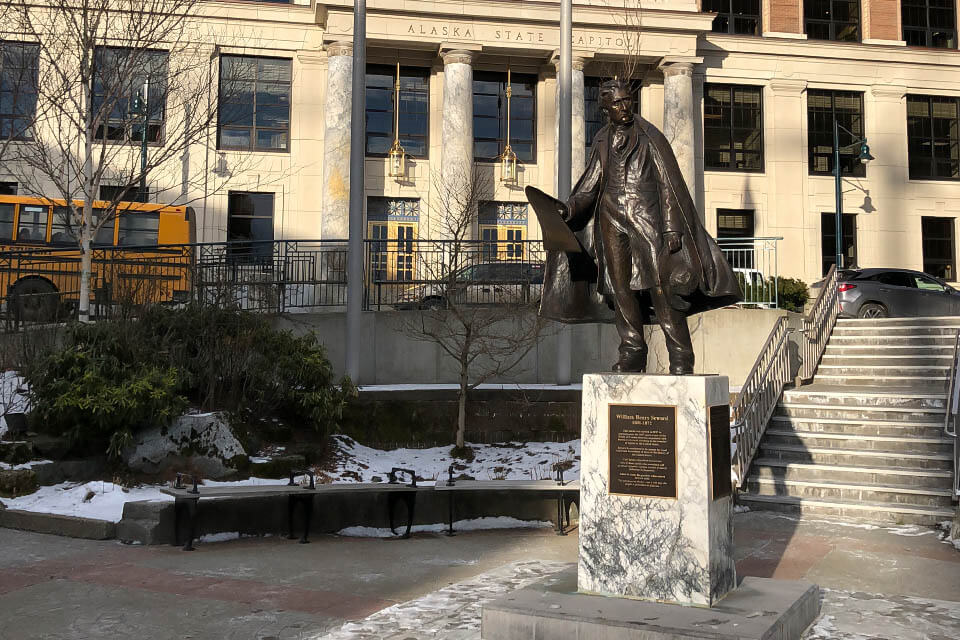
A statute of US Secretary of State under President Abraham Lincoln, William Seward and another statue of a Russian Bear eating a salmon grace the plaza in front of the Alaska Capital.[1].

After returning home from working for a legislator during the second half of the 30th Alaska Legislature, I have had some time to think about what happened between January and May of 2018–and what readers should know about the process.
Few Alaskans ever really go to Juneau and experience the place first-hand as it is in session. The expense is too great for a casual visit even though we all have a great financial interest.
Back in 2018 I provided an overview of how the Alaska Legislature works as I might explain it to a class of adult learners such as I taught over 10-1/2 years in Anchorage and the Mat-Su Valley. My goal remains to be non-partisan and instructional so that any teacher in Alaska government schools might be able to look with their class at how this Alaska phenomenon works.
For this discussion imagine you are in a sports arena with an overview from the stands, and you also have big screen televisions (Government Public Broadcasting KTOO360TV) all around to see what is happening up close in a variety of simultaneous committee venues. This arrangement is the result of Alaskans long ago wanting the Capital moved from Juneau to a place more accessible to Alaskans. Instead, we were promised to have accessibility as good as if we were there.
To this day the joke is on us and anybody who has tried to testify online knows this.
Alaska’s Capital Move Efforts; O Yea of little Faith
https://donnliston.net/2019/01/alaskas-capital-move-efforts-o-ye-of/

This is the nitty-gritty of how it works.
Voters choose from people who have offered themselves to serve as candidates for house or senate seats in this arena. And, when elected they go to Juneau where there is a system for what they do. To influence that system–beyond just voting–you must understand it.
The last time I worked in the Alaska Legislature was in 1983—the 13th Alaska Legislature. Then, and still, upon arriving at the Capitol, the elected legislators met and decided on where everybody will have offices, what kinds of furniture they will get from supply, how many staff will serve in each office, and other issues related to making each legislator functional. Legislative Affairs Agency (LAA) is a big machine, which hires all staff, provides basic training, and assures consistency in how the legislature operates from session to session.
Legislators may hire staff but staff are employees of LAA and can be fired by LAA.
In the big picture, some legislators get to drive the train, some get to shovel coal, and some just get to blow the whistle once in a while. How the legislature organizes itself at the start of each two-part session determines who gets the best offices and the levels of staff to help out. There are rules for everything, and protocols and expectations you might not know about until you do something you weren’t supposed to do.
For background, we all know there are three branches of the government, as established in the Alaska Constitution, built around the twin doctrines of “separation of powers” and “checks and balances.” LAA commissioned Gordon S. Harrison, Ph.D, to write Alaska’s Constitution, A Citizen’s Guide, to explain this document. It is an important reference document for dealing with State government.[2]
The Legislature includes the Senate and the House, with the 20 Senators elected from districts lettered A-T and 40 House members elected two to each Senate District numbered 1-40 (Two House districts within each Senate district). LAA maintains the webpage for the state public officials including the legislature, and anyone wanting to influence the Alaska Legislature should bookmark this website: http://akleg.gov/index.php
Legislative Finance is the branch of LAA that provides financial oversight information for the legislature. All members of this powerful agency are based in Juneau.[3]
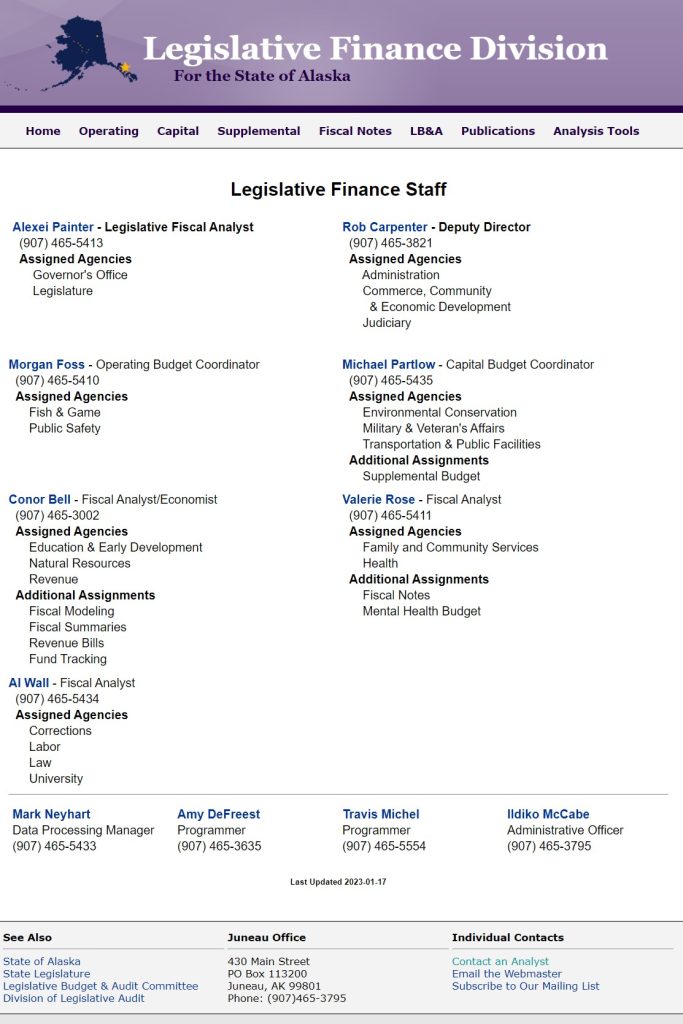
Executive Branch includes the governor, Department Commissioners, and all the general state workforce. The governor proposes a budget which is developed out of the Office of Management and Budget (OMB). Legislative Finance handles the budget on the legislative side but only the governor knows where all of Alaska’s money is being spent:
Judicial Branch includes the court system with four judicial districts having a structure that is centrally administered to assure laws established by the legislature, and enforced by the Executive Branch, are followed according to the constitution on a case-by-case basis.
The Legislature as an Institution
I have always been enamored with the legislative branch of government because this is the body closest to the people. Each representative serves a district established in reapportionment after each 10-year census, representing a general geographical area and roughly 1/40th of the population of the state. Alaska’s population of approximately 732,673 (2021) people means an elected house member typically represents around 18,300 people; a senator represents twice that number, 37,000 people.
You’ve got to ask: “How could one person represent that many people?”
It begins by getting elected. To represent the majority of people in a house district, candidates must become well known, project their views, and gain support from a majority of voters. The two major parties—Democrats and Republicans—exist to elect candidates who represent their values and aspirations as established in party rules, district conventions, and finally state conventions. These conventions arrive at platforms and statements of intent that their respective candidates are expected to follow. Candidates who run as Democrats or Republicans don’t always adhere strictly to the party platform, but generally, those are the parties who promote candidates elected to go to Juneau to represent their respective districts. The two-party system assures that a representative or senator is chosen by a majority of Alaskans.
To learn more about political parties and election results, go to the Alaska Division of Elections webpage.[4]
The Legislative session is held over two years, so the 30th session began in January of 2017 and ended in May 2018, with a many-months-long break in the middle of that time. By statute, each part of the two-year session is supposed to go no more than 120 days (wink-wink).
The legislature determines what laws are on the
books and who gets what.
Regular sessions of the Alaska Legislature convene each year on the fourth Monday in January. Upon arriving in Juneau for the session, elected members must first organize; Majority Caucus and Minority Caucus are formed. The majority runs the show; the minority gets to challenge and complain and try to get what they aspire to by teaming up with any who will work with them on bills and the budget they want to pass.
Everything requires 21 votes in the House,
11 in the Senate.
If you ain’t got the votes you ain’t got squat.
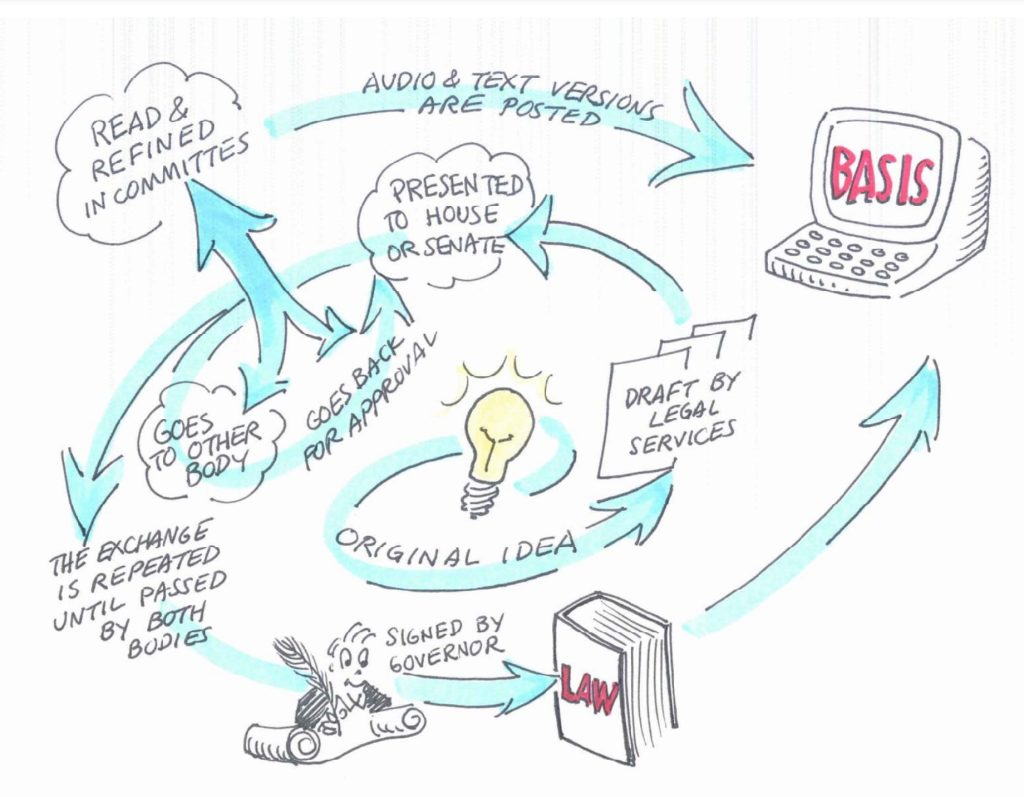
These are required steps to pass a bill into law:
A bill must go through three readings on three separate days. The Order of Business of each floor session is established in the Uniform Rules.[5]
The clerk of each body reads the title of each bill to be introduced in First Reading at the beginning of each floor session. The presiding officer then assigns each to committees for consideration, public hearing and change according to the will of the committees. Amendments are made to the text of a bill in Second– or Third-Reading and the bill must pass either the house or senate by a floor vote after debate. If a bill passes one body it must next go to the other body for consideration. If it passes that body without any changes then it goes to the governor, who must sign it within a designated time, let it pass by not taking any action, or veto it. If changes are made to a bill passed by one body those changes require the bill to return to the originating body for concurrence. If the governor vetoes a bill it can be overridden by a two-thirds majority vote to pass it over a governor’s veto.
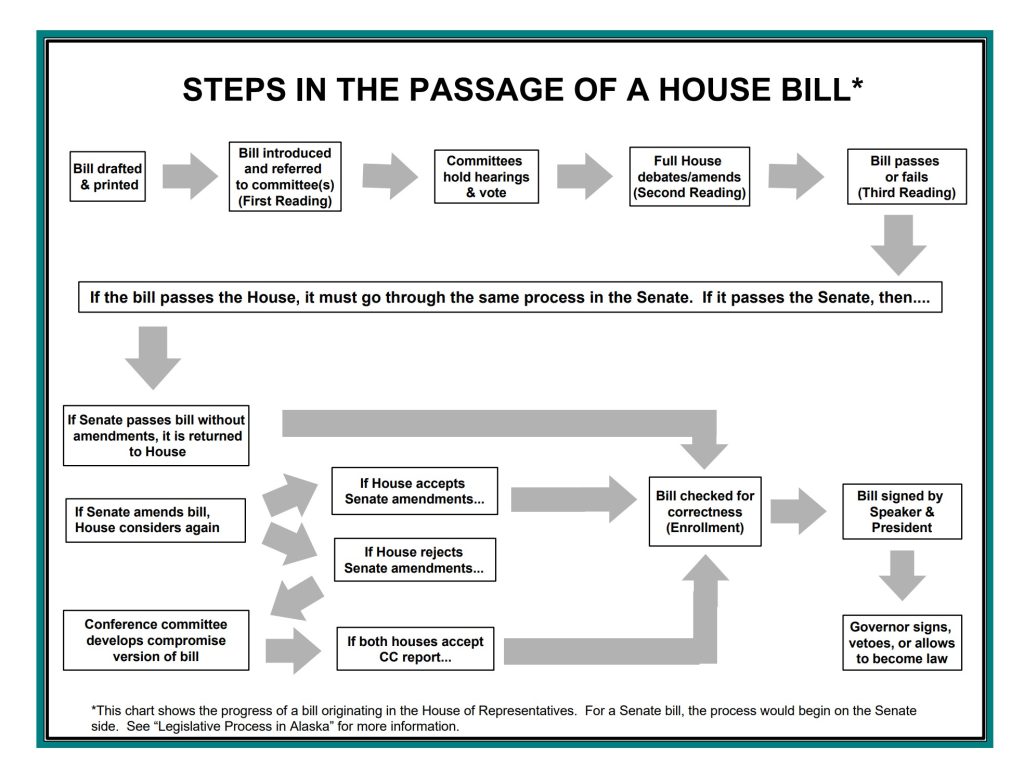
While this is generally how it works there are exceptions and adaptations in the rules. Also, rules can be changed on a temporary basis.
Thia all may sound complicated but with each legislative floor session, the process gets a rhythm to it. Watching from the public gallery (or by video feed) an observer can see that each bill is introduced matter-of-fact, given committee assignments, and brought back for Second and Third Readings over time.
These are the general dynamics of how the legislature works. My overview here is only introductory.
Each elected representative or senator is vying for passage of legislation that will modify, eliminate or create new laws, AND provide a budget, to protect or otherwise impact Alaskans and maintain State Government. Whether the particular law is bad or good for Alaskans sometimes depends upon what happens after it is passed. But the good news is that every vote of every elected legislator is recorded and available for consideration by voters at the next election.[6]
When you click on the particular legislator you can find all bills they sponsored or co-sponsored, and click on each individual bill to see what it was about.
Informed voters ask candidates for public office about their views on issues of importance and consider the candidate’s credibility. A candidate who says one thing on the campaign trail can be validated by their voting record. Taking a stand on an issue may be easy to do when campaigning for office, but difficult to maintain when a variety of variables are brought into the formula. That is why you must never vote for somebody based on one issue alone. Further, debate in committee and on the floor of the Alaska House or Senate provide a true reading on where elected officials actually stand after campaign rhetoric is over. Bill information and video debates in committee or on the floor of the 30th Legislature can be found at www//akleg.org.
Debate and Decision Making
Unstated is the understanding there will be no hitting, kicking or spitting on the floor of the legislature. In fact, going onto the floor of the legislature is a solemn act. Everything begins day one with the Lt. Governor calling each house to order separately and calling the roll of members whose elections have been certified. Instructional note: The Lt. Governor administers elections, appoints notaries public, serves as custodian of the state seal and performs certain ministerial duties related to the promulgation of regulations under the Administrative Procedures Act.
Each house has a presiding officer; Senate President and Speaker of the House. They each call the body to order and run the show. The presiding officer sits at the front of the legislative chamber facing all of the members and the primary aisle from the back to the front of the chamber. When recognized by the presiding officer, members must rise to speak. The Majority Leader sits in the front corner desk facing forward on one side of the aisle nearest the podium. The Minority Leader sits in the corresponding corner desk on the other side of the aisle. Because the presiding officer is selected by a majority of members, the Majority Leader is most active in routine procedures to facilitate efficient processing of the people’s business, jumping up and sitting down frequently, to address the speaker.
Besides determining which committees each newly introduced bill will be referred to in First Reading, each presiding officer conducts and manages orderly debate on the floor through the entire process. In Second Reading the bill and committee reports are presented so the bill can be amended on the floor and may move to Third Reading. This is the point where placement on the floor by the Rules Committee determines calendar assignment for final debate and consideration for passage of any bill. Chances for a bill to pass through the legislature are sometimes apparent at First Reading according to the number of committees it must go through. If the presiding officer makes a ruling on anything during debate–that any member objects to–it can be voted on and either allowed or discarded by majority rule.
Under Rule 20, Standing Committees, each house of the Alaska Legislature has the following committees: Education, Finance, Health and Social Services, Judiciary, Labor and Commerce, Community and Regional Affairs, Resources, Rules, State Affairs and Transportation.
During the 30th Session this writer witnessed the proposed “Red Shirt Law,” HB 75 “Gun Violence Protection Orders” come before the Judiciary Committee. Originator of that bill, Geran Tarr from District 19 (East Anchorage) explained her bill and committee members questioned people who gave testimony on it.
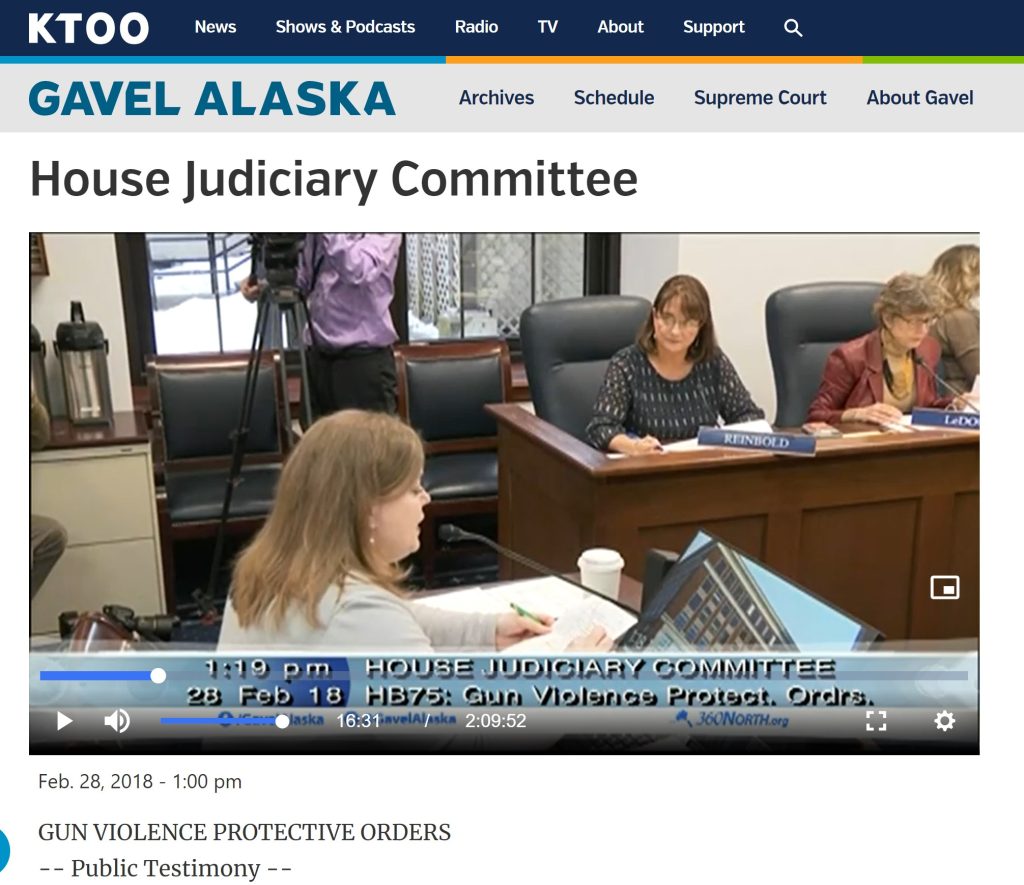
Rep. Lora Reinbold questioned Rep. Geran Tarr about her proposed Gun Violence Protective Order bill. See the hearing here: https://www.360north.org/gavel/video/?clientID=2147483647&eventID=2018021380
This bill did not pass the Legislature, but it went through some major changes and might have passed with more support from the Majority Caucus.
Passing the Budget is a Big Deal!
Under the Alaska Constitution appropriation bills must be confined to appropriations to prevent substantive law from being enacted with a spending bill. The problem is the state budget is so complicated that only experts know what is in it and where money is hidden. Caucuses sometimes require that all members vote the same way on the budget in what is known as a Binding Caucus. Several legislators have been subject to discipline from their caucus for violating this practice.[7]
Each agency of state government has a person, usually in the Commissioner’s Office, who is the direct contact for any questions or concerns of legislators or staff, with specialists for special areas of concern like Capital Budget Coordinator and Fund Tracking. They know what information is worth and who they prefer to have it. Constituent requests for information can result in questions to these bureaucrats.
All of these bureaucrats reside primarily in Juneau. All have a vested interest in knowing more than any legislator can about the inner workings of state government. To change that dynamic more Alaskans must become familiar with how our state budget is developed each year. Everything else going on—the theater, the ceremony, the minutia of legislative procedures and intrigue—are all subordinate to how elected officials decide how our resource wealth is spent.
Do you need any more reasons for monitoring
and participating directly
in the Juneau Circus?
References:
[1]https://en.wikipedia.org/wiki/Russian_Bear
The Russian Bear (Russian: Русский медведь, romanized: Russky medved) is a widespread symbol (generally of a Eurasian brown bear) for Russia, used in cartoons, articles and dramatic plays since as early as the 16th century,[1] and relating alike to the Russian Empire, the Russian Provisional Government and Russian Republic, the Soviet Union, and the present-day Russian Federation.
[2]Alaska’s Constitution, A Citizen’s Guide
https://akleg.gov/docs/pdf/citizens_guide.pdf
[3]Legislative Finance
https://www.legfin.akleg.gov/AgencyInfo/AboutLFD.php
The Legislative Finance Division (LFD) provides non-partisan budgetary and fiscal analysis to the Alaska Legislature. LFD supports the finance committees in both bodies during the development of the State’s budget by providing accurate, relevant and objective information and analysis so that lawmakers can make budgetary decisions. LFD operates under a policy of confidentiality in all budget work and personal requests by legislators and aides are confidential until released by the requester or discussed at a public meeting.
[4]Alaska Division of Elections: https://www.elections.alaska.gov/Core/generalelectioninformation.php
[5]Uniform Rules
https://akleg.gov/docs/pdf/uniform_rules.pdf
[6]Voting Records:
To examine the voting record of any Alaska Senator go here: http://akleg.gov/senate.php
For any Representative go here: http://akleg.gov/house.php
[7]Sen. Shelley Hughes Speaks Out
